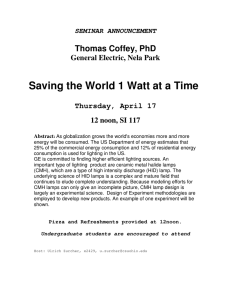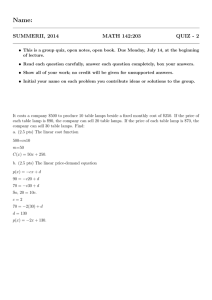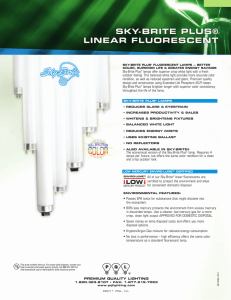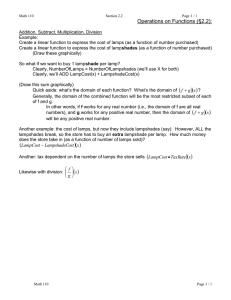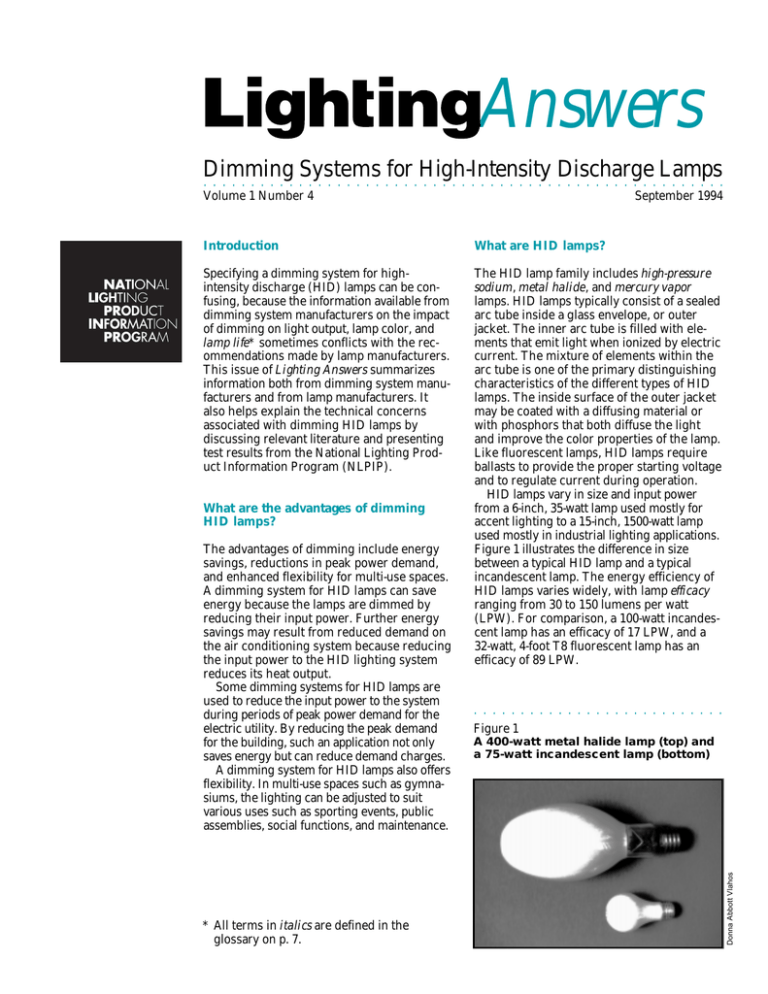
Answers
Dimming
Systems for High-Intensity Discharge Lamps
. . . . . . . . . . . . . . . . . . . . . . . . . . . . . . . . . . . . . . . . . . . . . . . . . . . . . . .
Volume 1 Number 4
September 1994
Introduction
What are HID lamps?
Specifying a dimming system for highintensity discharge (HID) lamps can be confusing, because the information available from
dimming system manufacturers on the impact
of dimming on light output, lamp color, and
lamp life* sometimes conflicts with the recommendations made by lamp manufacturers.
This issue of Lighting Answers summarizes
information both from dimming system manufacturers and from lamp manufacturers. It
also helps explain the technical concerns
associated with dimming HID lamps by
discussing relevant literature and presenting
test results from the National Lighting Product Information Program (NLPIP).
The HID lamp family includes high-pressure
sodium, metal halide, and mercury vapor
lamps. HID lamps typically consist of a sealed
arc tube inside a glass envelope, or outer
jacket. The inner arc tube is filled with elements that emit light when ionized by electric
current. The mixture of elements within the
arc tube is one of the primary distinguishing
characteristics of the different types of HID
lamps. The inside surface of the outer jacket
may be coated with a diffusing material or
with phosphors that both diffuse the light
and improve the color properties of the lamp.
Like fluorescent lamps, HID lamps require
ballasts to provide the proper starting voltage
and to regulate current during operation.
HID lamps vary in size and input power
from a 6-inch, 35-watt lamp used mostly for
accent lighting to a 15-inch, 1500-watt lamp
used mostly in industrial lighting applications.
Figure 1 illustrates the difference in size
between a typical HID lamp and a typical
incandescent lamp. The energy efficiency of
HID lamps varies widely, with lamp efficacy
ranging from 30 to 150 lumens per watt
(LPW). For comparison, a 100-watt incandescent lamp has an efficacy of 17 LPW, and a
32-watt, 4-foot T8 fluorescent lamp has an
efficacy of 89 LPW.
The advantages of dimming include energy
savings, reductions in peak power demand,
and enhanced flexibility for multi-use spaces.
A dimming system for HID lamps can save
energy because the lamps are dimmed by
reducing their input power. Further energy
savings may result from reduced demand on
the air conditioning system because reducing
the input power to the HID lighting system
reduces its heat output.
Some dimming systems for HID lamps are
used to reduce the input power to the system
during periods of peak power demand for the
electric utility. By reducing the peak demand
for the building, such an application not only
saves energy but can reduce demand charges.
A dimming system for HID lamps also offers
flexibility. In multi-use spaces such as gymnasiums, the lighting can be adjusted to suit
various uses such as sporting events, public
assemblies, social functions, and maintenance.
* All terms in italics are defined in the
glossary on p. 7.
. . . . . . . . . . . . . . . . . . . . . . . . . . .
Figure 1
A 400-watt metal halide lamp (top) and
a 75-watt incandescent lamp (bottom)
Donna Abbott Vlahos
What are the advantages of dimming
HID lamps?
set to the dimmed setting, the circuit includes
an additional capacitor, resulting in a fixed
reduction in power and light output.
Three methods are used for continuous
dimming of HID lamps. The first uses a variable-voltage transformer to reduce the primary voltage supplied to the ballast, dimming
to approximately 60% of rated lamp power.
The second method adds a variable reactor to
the circuit, which changes the lamp current
without affecting the voltage. This allows a wider
range of dimming, to approximately 30% of rated
power, depending on the lamp and ballast combination. The third method uses solid-state
components to change the waveforms of both
the current and voltage input to the ballast,
dimming to approximately 50% of rated power.
Some dimming systems for HID lamps
require special dimming ballasts, whereas
others use standard HID ballasts. In both
cases, only magnetic ballasts presently are
used. Some manufacturers are developing
electronic dimming ballasts for HID lamps,
which may provide further energy savings
and improved dimming performance.
Three types of dimming controls are
available: manual (local or remote), automatic
(with occupancy sensors or photocells), and
time-programmable. Systems are available to
control either a single zone or multiple zones.
HID lamps require a warm-up period to
reach full light output. When shut off, they
must cool down before they can be restarted
and then must warm up again to reach full
light output. The time required for the lamp
to restart is called the restrike time. Table 1
shows typical warm-up and restrike times for HID
lamps, along with some other characteristics.
Their long warm-up and restrike times
make HID lamps unsuitable for many applications. However, HID lamps can offer higher
lamp efficacy and higher light output than
incandescent or fluorescent lamps. HID
lamps also are more compact than 4- and
8-foot fluorescent lamps. As a result, their
light output is more easily controlled by
luminaires. Unlike fluorescent lamps, HID
lamp light output is not significantly affected
by ambient temperature.
What technologies are used to dim HID
lamps?
Presently, HID lamps can be dimmed using
two-level or continuous systems. Two-level
dimming is technologically simpler and thus
less expensive than continuous dimming. Most
two-level dimming systems use a constantwattage autotransformer (CWA) ballast; when
. . . . . . . . . . . . . . . . . . . . . . . . . . . . . . . . . . . . . . . . . . . . . . . . . . . . . . .
Table 1
Operating characteristics of HID lamps and ballasts
Lamp Type
Power
(watts)
Initial System
Efficacy
(LPW)*
Lumen
Depreciation
(%)**
Average
Rated Life
(hours)
Warm-up
Time
(minutes)
Restrike
Time
(minutes)
High-pressure
sodium
35–1,000
51–130
9–10
7,500–24,000+
3–4
0.5–1
Mercury vapor
40–1,250
24–60
11–25
12,000–24,000+
5–7
3–6
Metal halide
70–1,500
69–115
20–23
5,000–20,000+
2–5
10–20
* Efficacy calculation includes ballast power.
** Percentage reduction in light output at 40% of rated life.
2
. . . . . . . . . . . . . . . . . . . . . . . . . . . . . . . . . . . . . . . . . .
Figure 2
Light output vs. system input power for a 400-watt, coated
metal halide lamp
Relative light output (percent)
100
80
60
40
Light output measured by NLPIP
20
Light output if efficacy were constant
0
100
90
80
70
60
Relative system input power (percent)
50
. . . . . . . . . . . . . . . . . . . . . . . . . . . . . . . . . . . . . . . . . .
Table 2
Changes in efficacy for a 400-watt,
coated metal halide lamp
System
Input Power
(watts)
Relative Efficacy
(%)*
439
100
393
91
354
82
302
79
260
67
247
59
* Relative light output divided by relative system
input power.
How does dimming affect light output
and system input power?
Reducing the system input power does not
proportionally reduce light output. When
HID lamps are dimmed, the reduction in light
output is greater than the reduction in system
input power. Thus, the efficacy decreases as
the lamp is dimmed. Figure 2 displays the
results of NLPIP’s evaluation of a continuous
dimming system operating a 400-watt, coated
metal halide lamp. Table 2 lists the relative
efficacies of this system as NLPIP dimmed
the lamp in sequence to approximately 90, 80,
70, 60, and 55% power.
NLPIP also evaluated a two-level dimming
system operating a 400-watt, coated highpressure sodium lamp. For this evaluation,
NLPIP switched the system from the high
setting (approximately 100% power) to the
low setting (approximately 30% power). After
the lamp had stabilized at the low setting, its
light output was 10% of that at the high setting and the resultant efficacy was 39% of that
at the high setting.
According to some dimming system manufacturers, HID lamps used with their systems
do not immediately adjust light output when
the dimming setting is changed. When these
systems are dimmed from full power to minimum power, about half of the total change in
light output occurs within a few seconds. It
may then take 3 to 10 minutes for the light
output to stabilize. With some dimming
systems, lamps respond instantly to small
changes in input power.
According to some lamp manufacturers,
the lamp lumen depreciation of metal halide
and mercury vapor lamps may increase when
the lamps are dimmed, because operation at
reduced power increases the blackening of
the arc tube due to electrode sputtering. To
help limit lamp lumen depreciation of metal
halide and mercury vapor lamps, lamp manufacturers recommend that they not be
dimmed below 50% of rated power. This
recommendation is also important for lamp
life and color as discussed on pp. 4 and 5.
Lamp manufacturers also state that lamp
lumen depreciation of high-pressure sodium
lamps is not affected by dimming.
3
How does dimming affect color?
Of the three HID lamp types, metal halide
lamps are the most susceptible to changes
in color characteristics when dimmed. Dimming can reduce the arc tube temperature to
the point where some of the elements will not
ionize, which eliminates the contribution of
these elements to the lamp’s spectrum. According to some manufacturers, the change
in correlated color temperature (CCT) is slight
when a metal halide lamp is dimmed to 80% of
its rated power. However, the CCT increases
significantly when the lamp is dimmed below
60%, so that the light produced appears to be
more blue.
The effect of dimming on CCT and
color rendering index (CRI) value is less for
phosphor-coated metal halide lamps than for
clear lamps. When a clear metal halide lamp is
dimmed to 50% of rated power, the CRI value
may drop from 65 to 45 and the CCT may
increase by 1500 K. When a coated metal
halide lamp is dimmed to 50% of rated power,
the CRI value may drop from 70 to 60 and the
CCT may increase by only 400 K. Figures 3
and 4 show the effects of dimming on the
CCTs and CRI values of metal halide lamps.
To minimize color shift, some lamp manufacturers recommend that metal halide lamps be
operated close to their rated power and never
be dimmed below 50% of their rated power.
The CCTs of high-pressure sodium lamps
may decrease by 50 to 200 K when they are
dimmed; the light appears to be more yellow.
CRI values change minimally when highpressure sodium lamps are dimmed. The
color properties of mercury vapor lamps do
not change significantly when the lamps are
dimmed. For more information about the
impact of dimming on lamp color, see the
sidebar on p. 5.
How does dimming affect HID lamp life?
Although NLPIP did not test the effect of dimming on lamp life, others have published information and recommendations on HID lamp life.
Two recent studies of two-level dimming
systems (Smith and Zhu 1993; Gibson 1994),
in which the lamps were alternately operated
at full power and at reduced power, found no
significant change in lamp life. Nevertheless,
lamp manufacturers usually caution that
operating a lamp continuously at a very low
power level reduces lamp life and increases
lamp lumen depreciation. For example, manufacturers warn that dimming below 50% of
rated power may cut mercury vapor lamp life
in half, and may reduce high-pressure sodium
and metal halide lamp life by 90%.
Lamp manufacturers recommend that after
starting an HID lamp, the dimming system
should operate the lamp at full power for 10
to 15 minutes before dimming. One continuous dimming system that NLPIP evaluated
met this recommendation by maintaining full
power for about 15 minutes each time the
lamp was started, regardless of the dimming
system’s setting. Some metal halide lamp
manufacturers also recommend operating
the lamps in the base-up position for dimming to limit reduction in lamp life.
. . . . . . . . . . . . . . . . . . . . . . . . . . . . . . . . . . . . . . . . . . . . . . . . . . . . . . .
Figure 3
Figure 4
Effects of dimming on the CCTs of
400-watt, clear and coated metal
halide lamps (Adapted from Gibson 1994)
Effects of dimming on the CRI values
of 400-watt, clear and coated metal
halide lamps (Adapted from Gibson 1994)
5500
Change in CRI value
5000
CCT (K)
0
Clear
Coated
4500
4000
3500
3000
2500
-10
-15
Clear
Coated
-20
-25
400
360
320
280
240
Lamp operating power (W)
4
-5
200
400
360
320
280
240
Lamp operating power (W)
200
During dimming operation, systems
should maintain the minimum open-circuit
voltage established by the American National
Standards Institute (ANSI). If this voltage is
too low, it may be difficult to restrike the
lamp if power is interrupted momentarily.
Two-level dimming systems are preferred to
automatic on/off controls due to lengthy warmup and restrike times with on/off systems.
Continuous dimming systems are suited
for multi-use applications where flexibility is
needed or for applications where a control
system is used to regulate the illuminance.
They are used in airports, industrial buildings, lobbies, classrooms, gymnasiums, ice
rinks, sporting arenas, and auditoriums.
These systems sometimes use photocells,
either to dim lamps based on the availability
of daylight, or to compensate for lamp lumen
depreciation by dimming the lamps when they
are first installed. In the latter application, the
system gradually provides more power to
maintain a constant illuminance.
High-pressure sodium lamps typically are
used in industrial buildings, warehouses, and
parking lots. Metal halide lamps often are
preferred in locations where color is important, such as supermarkets, gymnasiums, ice
rinks, and sporting arenas.
What applications are best suited for
dimming HID lamps?
Two-level dimming systems are particularly
useful for parking lots. Lamps can operate at
full power during the primary hours of use,
after which the system can dim the lamps to
the low setting and provide uniform security
lighting all night. An added benefit of the use
of these systems in parking lots is the reduction of undesired light illuminating the adjoining properties.
For indoor applications, two-level systems
can be used effectively with occupancy sensors or timers in spaces such as warehouses.
In supermarkets, malls, and other retail
applications, dimming the lamps to provide a
low level of lighting for after-hours tasks
such as maintenance and restocking inventory reduces energy costs during those times.
Effect of dimming on the spectral power distribution of HID lamps
SPD curves for a 400-watt,
coated metal halide lamp
SPD curves for a 400-watt, coated
high-pressure sodium lamp
100% power
700
740
700
740
620
620
580
540
500
460
0
420
740
700
1.0
380
Relative
radiated power
Wavelength (nm)
660
620
580
540
500
580
30% power
0
460
660
50% power
420
540
Wavelength (nm)
1.0
380
660
Wavelength (nm)
500
380
460
0
740
700
660
620
580
540
500
460
420
0
1.0
420
Relative
radiated power
1.0
380
Relative
radiated power
100% power
Relative
radiated power
A spectral power distribution (SPD)
curve illustrates the relative power
radiated by a lamp at each given
wavelength. NLPIP measured the SPD
and CCT for HID lamps operated by
two dimming systems at full power and
at reduced power.
The two bar charts on the left show
the SPD curves for a 400-watt, coated
metal halide lamp operated by a
continuous dimming system, at 100%
and 50% power. When the lamp was
dimmed, radiant power was substantially
reduced at all wavelengths and the SPD
curve resembled that of a mercury vapor
lamp. The CCT shifted from 3850 to 4310 K.
The metal halide lamp that NLPIP
tested had a sodium-scandium lamp
chemistry, which is typical of 400-watt
metal halide lamps. The color properties
of other metal halide lamp types may be
affected differently by dimming.
The two bar charts on the right show
the SPD curves for a 400-watt, coated
high-pressure sodium lamp operated
by a two-level (100% and 30%) dimming
system. When the lamp was dimmed,
the SPD curve resembled that of a lowpressure sodium lamp, and the CCT
shifted from 2070 to 1990 K.
Wavelength (nm)
5
Who manufactures dimming systems for
HID lamps?
What warranties are available for these
dimming systems?
NLPIP identified six manufacturers of dimming ballasts or controls for HID lamps and
sent surveys to all of them. Table 3 summarizes product information from the three
manufacturers that responded to the survey.
NLPIP also investigated the costs of dimming systems for HID lamps. Installed costs
vary widely, based on the type of dimming
system and on the specific details of the
application. Specifiers should contact dimming system manufacturers with these
details to obtain accurate pricing information.
Some dimming system manufacturers void
their warranties if components of their dimming systems are used with controls or ballasts from another manufacturer. Warranties
may or may not include the costs of transportation and replacement labor and sometimes
include either repair or replacement at the
manufacturer’s discretion. Some HID lamp
manufacturers void their warranties when
lamps are operated on a dimming system,
unless the dimming system has been approved by the lamp manufacturer.
. . . . . . . . . . . . . . . . . . . . . . . . . . . . . . . . . . . . . . . . . . . . . . . . . . . . . . .
Table 3
Availability of some HID dimming systems
100
Two-Level Dimming
Continuous Dimming
Lamp Input Power (watts)
Lamp Input Power (watts)
150
150
175
250
400
1000 1500 100
175
250
400
1000 1500
High-pressure sodium
Lutron Electronics Co., Inc.*
Peschel Energy, Inc**
•
•
•
•
•
Wide-Lite/Control*
•
•
•
•
•
•
•
•
•
•
•
•
•
•
•
•
•
•
•
•
•
Mercury vapor
Peschel Energy, Inc**
•
•
Wide-Lite/Control*
•
•
•
•
•
•
•
•
•
•
Metal halide
Lutron Electronics Co., Inc.*
Peschel Energy, Inc**
Wide-Lite/Control*
•
•
•
•
•
•
•
•
•
•
•
•
•
•
•
•
•
•
•
•
•
•
•
•
•
•
•
•
•
•
•
•
Indicates that a dimming system for that lamp wattage was available as of January 1994.
Only manufacturers that responded to NLPIP’s survey are included.
* Products are available for both 120- and 277-V operation.
** Products are available for 120-, 277-, and 347-V operation.
6
Glossary
. . . . . . . . . . . . . . . . . . . . . . . . . . . . . . . . . . . . . . . . . . . . . . . . . . . . . . .
lamp life The median life span of a very
of the degree of color shift that objects unlarge number of lamps. Half of the lamps in a
dergo when illuminated by a lamp, compared
sample are likely to fail before the rated lamp
with those same objects when illuminated by
life, and half are likely to survive beyond the
a reference source of comparable CCT. A
rated lamp life. For discharge light sources,
CRI of 100 represents the maximum value.
such as fluorescent and HID lamps, lamp life
A lower CRI value indicates that some colors
depends upon the number of starts and the
may appear unnatural when illuminated by
duration of the operating cycle each time the
the lamp.
lamp is started. HID lamp life ratings are
based on a 10 hours on, 1 hour off operating
constant-wattage autotransformer
cycle, and range from 5,000 to more than
(CWA) The most common type of ballast
24,000 hours.
used for HID lamps; it maintains a constant
power (wattage) supply to the lamp when
lamp lumen depreciation (LLD) The
system input voltage fluctuates.
reduction in lamp light output that progressively occurs during lamp life. Phosphor
correlated color temperature (CCT) A
deterioration and blackening of the arc tube
description of the color appearance of a light
contribute to HID lamp lumen depreciation.
source. The CCT relates the color appearance
of the light emitted by a lamp to the color
mercury vapor (MV) A high-intensity
appearance of a reference material heated to
discharge lamp type that uses mercury as the
a high temperature (measured on the kelvin
primary light-producing element. Mercury
scale, abbreviated K). As the temperature
vapor lamps produce light with a CCT from
rises, the color appearance shifts from warm
3000 to 7000 K. Mercury vapor lamps with
to cool. Lamps with a low CCT (3100 K and
clear outer bulbs have CRI values from 15 to
lower) appear yellow-white and are described
25, whereas phosphor-coated lamps have CRI
as “warm”; lamps with a high CCT (4000 K
values from 40 to 55. Mercury vapor lamps
and higher) appear blue-white and are deare less efficacious than other HID lamp
scribed as “cool.”
types, typically producing only 30 to 65 LPW,
but they have longer lamp lives and lower
efficacy The ratio of light output (lumens)
initial costs than other HID lamp types.
to input power (watts), expressed in lumens
per watt (LPW).
metal halide (MH) A high-intensity discharge lamp type that uses mercury and
high-pressure sodium (HPS) A highseveral halide additives as light-producing
intensity discharge lamp type that uses
elements. Metal halide lamps have better
sodium under high pressure as the primary
color properties than other HID lamp types
light-producing element. High-pressure
because the different additives produce more
sodium lamps produce light with a CCT of
visible wavelengths, resulting in a more
approximately 2000 K, although CCTs for
complete spectrum. Metal halide lamps are
lamps with higher CRI values range from
available with CCTs from 2300 to 5400 K and
2200 to 2700 K. Standard lamps have a CRI
with CRI values from 60 to 93. Efficacies of
value of 22, others have CRI values from 60
metal halide lamps typically range from 75 to
to 80. They are among the most efficacious
125 LPW.
light sources, with efficacies as high as 150
LPW, although high-pressure sodium lamps
open-circuit voltage The voltage applied
with higher CRI values have efficacies as low
across the output terminals of a ballast when
as 25 LPW.
no load is connected. This is the voltage
applied across a lamp circuit to start the
illuminance The amount of light incident
lamp. After starting, the voltage rapidly
on a surface area. Illuminance is measured
decreases and stabilizes at the operating
in footcandles (lumens/square foot) or lux
voltage.
(lumens/square meter). One footcandle
equals 10.76 lux, although for convenience
restrike time The time required for a lamp
10 lux commonly is used as the equivalent.
to restrike, or start, after the lamp is extinguished. Normally, HID lamps need to cool
before they can be restarted.
.
color
rendering index (CRI) A measure
7
Resources
American National Standards Institute. 1988–1990. American National Standard for Electric Lamps: High-Pressure
Sodium Lamps, ANSI C78.1350-1990, C78.1351-1989,
C78.1352-1990, C78.1353-1990, C78.1354-1990, C78.13551989, C78.1356-1988, C78.1358-1988, C78.1359-1988. New
York, NY: American National Standards Institute.
———. 1990. American National Standard for Electric
Lamps: Metal-Halide Lamps, ANSI C78.1375-1990,
C78.1376-1990, C78.1377-1990, C78.1378-1990, C78.13791990. New York, NY: American National Standards
Institute.
———. 1992. American National Standard for Specifications for Mercury Lamps, ANSI C78.40-1992. New York,
NY: American National Standards Institute.
Gibson, R. G. 1994. Dimming of Metal Halide Lamps.
Journal of the Illuminating Engineering Society 23(2):19–25.
Illuminating Engineering Society of North America.
1993. Lighting Handbook: Reference and Application. M.
Rea, ed. New York, NY: Illuminating Engineering
Society of North America.
Smith, D., and H. Zhu. 1993. Properties of High Intensity Discharge Lamps Operating on Reduced Power
Lighting Systems. Journal of the Illuminating Engineering Society 22(2):27–39.
NLPIP Publications
Guide to Performance Evaluation of Efficient Lighting
Products, 1991
Specifier Reports:
Power Reducers, 1992
Specular Reflectors, 1992
Occupancy Sensors, 1992
Parking Lot Luminaires, 1993
Screwbase Compact Fluorescent
Lamp Products, 1993
Cathode-Disconnect Ballasts, 1993
Exit Signs, 1994
Electronic Ballasts, 1994
Specifier Reports Supplements:
Screwbase Compact Fluorescent
Lamp Products, 1994
Lighting Answers:
T8 Fluorescent Lamps, 1993
Multilayer Polarizer Panels, 1993
Task Lighting for Offices, 1994
Dimming Systems for
High-Intensity Discharge Lamps
Volume 1, Number 4
September 1994
Authors: Yunfen Ji and Robert Wolsey
Testing: Andrew Bierman
Principal Investigator: Robert Davis
Project Director: Russell Leslie
Technical Review: Mark Rea
Editor: Amy Fowler
Production: Nancy Bayer and Martha Guilfoyle
Copyright © 1994 Rensselaer Polytechnic Institute. All rights reserved. No
portion of this publication or the information contained herein may be
duplicated or excerpted in any way in any other publications, databases, or
any other medium without express written permission of the publisher.
Making copies of all or part of this publication for any purpose other than
for undistributed personal use is a violation of United States copyright laws.
It is against the law to inaccurately present information extracted from Lighting
Answers for product publicity purposes. Information in these reports may not
be reproduced without permission of Rensselaer Polytechnic Institute.
The products described herein have not been tested for safety. The
Lighting Research Center and Rensselaer Polytechnic Institute make no
representations whatsoever with regard to safety of products, in whatever
form or combination used. The information set forth for your use cannot be
regarded as a representation that the products are or are not safe to use in
any specific situation, or that the particular product you purchase will
conform to the information found in this report.
ISSN 1069-0050
. . . . . . . . . . . . . . . . . . . . . . . . . . . . . . . . . . . .
For publications ordering information, contact:
Lighting Research Center
Rensselaer Polytechnic Institute
Troy, NY 12180-3590
Telephone: (518) 276-8716
Fax: (518) 276 -2999
Internet e-mail: LRC@rpi.edu
Lighting Answers is printed on a paper that is made from
50% recycled fiber, including 10% post-consumer waste.
Program Sponsors
Hydro-Québec
Iowa Energy Center
Lighting Research Center
New England Electric Companies
New England Power Service Company, New England Power
Company, Massachusetts Electric Company, The Narragansett
Electric Company, Granite State Electric Company
New York State Energy Research and
Development Authority
Northern States Power Company
Southern California Edison Company
PSI Energy
United States Department of Energy
United States Environmental Protection Agency
Wisconsin Center for Demand-Side Research
8
Lighting Answers is a serial that complements the National
Lighting Product Information Program’s (NLPIP) other serial,
Specifier Reports. Each issue of Lighting Answers presents
information in one of three formats: some issues present
educational information about a specific topic that is of concern to lighting professionals; some issues present a summary
of available information about a particular technology in an
educational format with no testing; and other issues present
information about a new or special technology on which NLPIP
has performed some limited testing. For this issue of Lighting
Answers, NLPIP summarized available information about dimming systems for HID lamps and performed limited testing.

